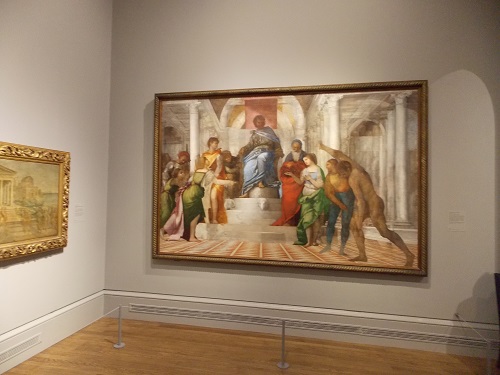NG1033 Sandro Botticelli The Adoration of the Kings, about 1470-5
Tempera on poplar ,130.8 x 130.8 cm,Bought, 1878
© The National Gallery, London
The National Gallery presents the first exhibition in Britain to explore the role of architecture within painting, with the focus on Italian Renaissance painting of the 14th, 15th and 16th centuries.
Building the Picture: Architecture in Italian Renaissance Painting aims to increase visitors’ appreciation and understanding of some of the most beautiful and architectural paintings by Italian masters such as Duccio, Botticelli, Crivelli, Veneziano, Mazzolini and their contemporaries.
Using the National Gallery’s famous collection of Italian Renaissance paintings, this exhibition will also include the Venetian master Sebastiano del Piombo’s The Judgement of Solomon (Kingston Lacy, The Bankes Collection, National Trust), on display in London for the first time in 30 years, and ‘The Ruskin Madonna’ by Andrea del Verrocchio (National Gallery of Scotland).
Building the Picture explores the roles played by architecture in painting and how it affects the viewing process. Architecture within paintings has often been treated as a passive background or as subordinate to the figures. This exhibition shows how, on the contrary, architecture underpinned many paintings, and was used to design the whole picture from the very start. This was the case in Sandro Botticelli’s Adoration of the Kings , where the ruins in the picture were planned first and still dominate the composition. Renaissance paintings are full of arches, doorways and thresholds.
Visiting London Guide Review
NG3919 Sandro Botticelli Three Miracles of Saint Zenobius, about 1500
Tempera on wood, 64.8 x 139.7 cm, Mond bequest, 1924
© The National Gallery, London
One of the aims of the Building the Picture: Architecture in Italian Renaissance Painting is to increase visitors’ appreciation and understanding of some of the most beautiful and architectural paintings by Italian masters such as Duccio, Botticelli, Crivelli and their contemporaries.
As you walk around the Exhibition with this is mind, it is quite enlightening to consider the background as well as foreground which usually takes your attention.
It is quite remarkable how many of the Renaissance painting use arches, doorways and thresholds to frame the action in the painting.
It is interesting how the subjects in the paintings are not over powered by the architecture but often seem to be larger than life.
Another interesting aspect is how the buildings give the picture a three dimensional quality and draws the viewer into the picture.
One of the benefits of looking at paintings from roughly the same era but different painters is that common themes are followed and similar painting techniques but each painter will try to be slightly different in the way present the picture.
The National Gallery should be applauded for putting on a exhibition which challenges the viewer to consider how a painting can be made up of different aspects which come together to make the whole more successful.
It also gives some insight into the mind of the Renaissance painter whose vision of beauty was not confined to human beings and nature but also to the bricks and mortar that could be used to create wonderful buildings sometimes in the imagination but also in reality.
The relatively small size of this exhibition gives the visitor plenty of time to look at the painting individually and in relation to each other. The exhibition is free so if you are visiting the National Gallery is one not to miss. It also forms part of the Renaissance Spring as season of exhibitions that include the Veronese and Strange Beauty Exhibitions.
If you are intrigued by the subject matter of the Exhibition, the National Gallery has commissioned five short films to coincide with this exhibition demonstrate how contemporary practitioners and thinkers are again blurring the boundaries between media and forms of practice. The films provide modern perspectives on real and imagined architecture from award-winning Swiss architect Peter Zumthor, film-maker Martha Fiennes, art historian T. J. Clark, film historian John David Rhodes and computer game cinematic director Peter Gornstein.
Also the Building the Picture: Architecture in Italian Renaissance Painting is an online exhibition catalogue produced by the National Gallery to accompany the exhibition. This digital catalogue will be accessible online here.
Dates and opening hours
Open to public: 30 April – 21 September 2014
Sunley Room
Admission free
Daily 10am–6pm (last admission 5pm)
Fridays 10am–9pm (last admission 8.15pm)
Visiting London Guide Rating – Highly Recommended






This exhibition actually feels larger than its four small rooms, perhaps because the message it conveys is big: take another look at those paintings which might seem familiar, and notice their architectural background… you might be surprised by what you find: http://artseer.wordpress.com/2014/05/02/building-the-picture-review-national-gallery/
Hi Alison,
I really enjoyed your review into the exhibition, your more in depth analysis brings out many of the themes, which I agree with you are quite considerable for quite a small exhibition.
I look forward to reading further reviews and who knows I maybe bump into you at one of the exhibitions.
Thanks! It was a great exhibition to review. Yes, hope to see you out there…